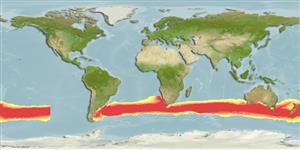Common names from other countries
>
Lampriformes (Velifers, tube-eyes and ribbonfishes) >
Regalecidae (Oarfishes)
Etymology: Agrostichthys: Greek, agros = field, country + Greek, ichthys = fish (Ref. 45335).
Environment: milieu / climate zone / depth range / distribution range
экология
морской. Temperate; 25°S - 59°S (Ref. 92949)
Southern Oceans: collected relatively neaer the surface over or near the continental slope of New Zealand, Australia (with Tasmania), southern Namibia, and Argentina (including Falkland Is or Malvinias.
Size / Вес / Возраст
Maturity: Lm ? range ? - ? cm
Max length : 300 cm TL самец/пол неопределен; (Ref. 4171)
Краткое описание
определительные ключи | морфология | морфометрия
колючие лучи спинного плавника (общее число) : 2 - 7; колючие лучи анального плавника: 0; членистые (мягкие) лучи анального плавника: 0. Distinguished in having just 6 to 9 gill rakers on the first gill arch, 8 to 11 pectoral fin rays, and just 2 caudal fin rays. Start of the dorsal fin having 1 to 3 simple elongated rays, apparently never ornamented; not forming a single or double crest but are membranously joined to each other as well as to the dorsal fin. No cristophore. Head is shallow, with gently sloping snout. (Ref. 92949). Body silvery in color. Dorsal fin rose-colored and with more than 400 soft rays (Ref. 4171). Opercular bones well-developed. Small, protrusible mouth, without visible teeth; premaxilla extending forward along dorsal profile of head; axis of maxilla oblique. Skin of fragmented body naked, studded with numerous hard tubercles. Lateral line runs along sides consisting of a chain of oblong plates to form a continuous tube (Ref. 43600).
Rare species, known from only seven specimens. Occurs in the open ocean habitat (Ref. 4171). Found only in the southern oceans from 25°S to 59°S. Apparently also capable of autotomy, unique amongst lampridiforms. Early life history stages (eggs and larvae) unknown. Predators, prey, and parasites unknown (Ref. 92949).
Life cycle and mating behavior
Maturities | размножение | Spawnings | Egg(s) | Fecundities | личинки
Heemstra, P.C., 1986. Regalecidae. p. 403. In M.M. Smith and P.C. Heemstra (eds.) Smiths' sea fishes. Springer-Verlag, Berlin. (Ref. 4171)
Статус Красного Списка МСОП (Ref. 130435)
CITES (Ref. 128078)
Not Evaluated
Угроза для людей
Harmless
Использование человеком
дополнительная информация
инструменты
Специальные отчеты
Скачать в формате XML
ресурсы в Интернет
Estimates based on models
Preferred temperature (Ref.
115969): 6.4 - 13.4, mean 9.5 (based on 127 cells).
Phylogenetic diversity index (Ref.
82804): PD
50 = 1.1250 [Uniqueness, from 0.5 = low to 2.0 = high].
Bayesian length-weight: a=0.00102 (0.00046 - 0.00225), b=3.06 (2.88 - 3.24), in cm Total Length, based on all LWR estimates for this body shape (Ref.
93245).
Trophic level (Ref.
69278): 3.4 ±0.5 se; based on size and trophs of closest relatives
Fishing Vulnerability (Ref.
59153): Very high vulnerability (90 of 100).
